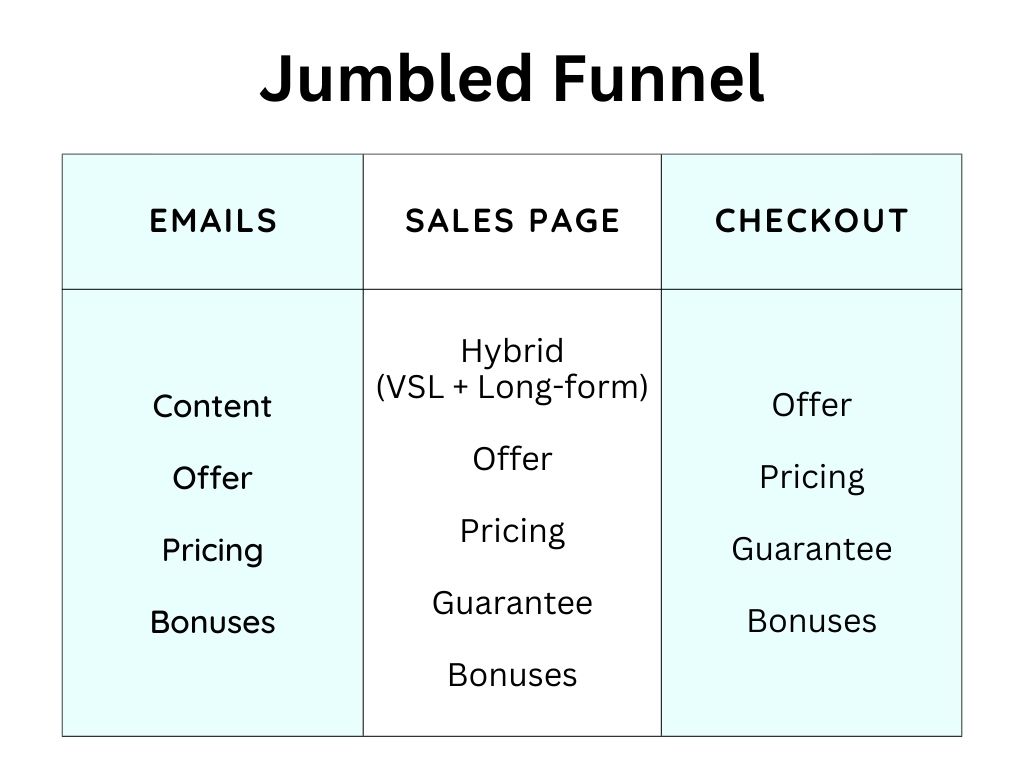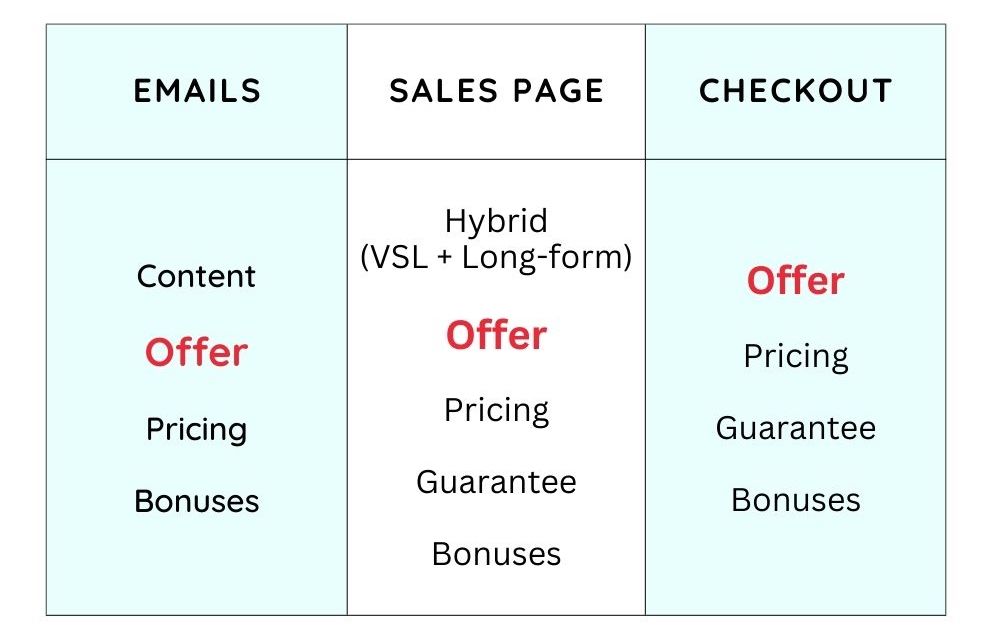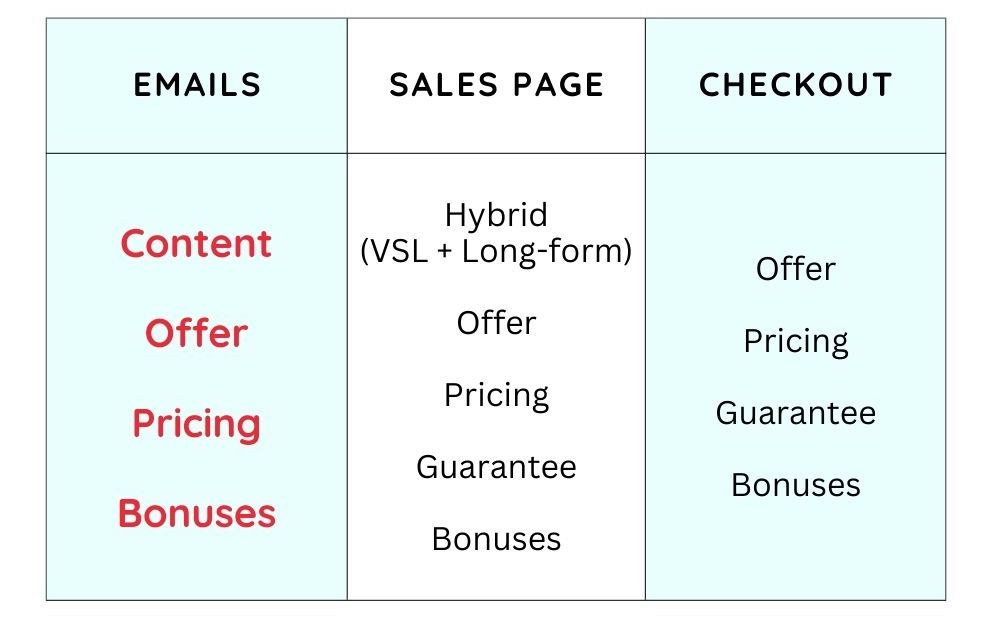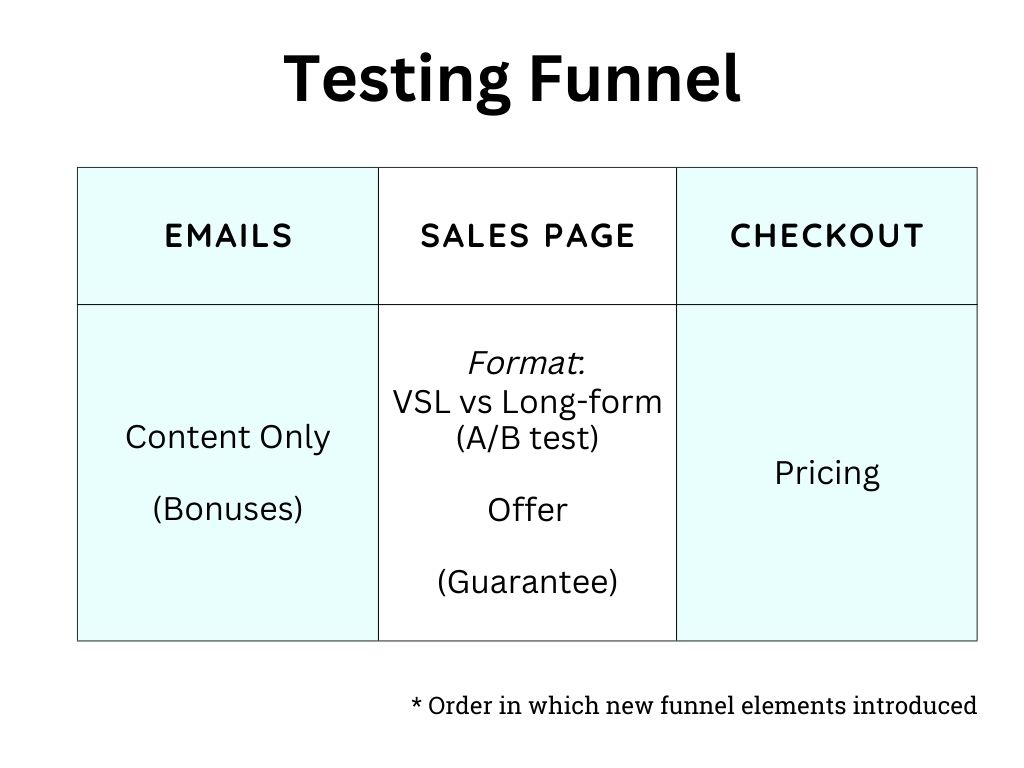So, you’ve got a new product.
Product is done.
You’re ready to start selling the thing.
But how?
Email sequence? Probably.
Sales page? Hopefully.
Checkout? Unless you hate money.
But there are more decisions…
- VSL or long-form sales page?
- Price on the sales page, or hide it till later?
- Mention the offer in emails or not?
Today, I’m going to show you how to sequence and stage all key parts of your funnel.

But we’re not optimising for sales.
We’re optimising for something altogether different.
But if you follow my method, you’ll get your sales funnels working 10X faster than most people.
Curious?
You should be.
After all, if you weren’t in the least by curious, this entire written intro would have fallen flat on its face.
So, go on…
Spare Uncle Olly’s blushes and keep reading to discover how to make more money from your sales funnels.
Messy Funnels Cost You Dearly
I remember when we first started working on the funnels in my language business, StoryLearning.
We wanted to increase conversion, so we could make more revenue per lead.
Our funnels were a random hodgepodge of emails, videos, bonuses, etc that had been strung together over many years.

Random things added in and out…
P.S.’s galore…
URLs flying every which way to Sunday…
A classic bootstrapped funnel situation!
We had a conversion expert come in.
He took one look at what we had going on and said:
“This is gonna take a while!”
Reason was, everything was so muddled up that:
It was impossible to determine which element of the funnel was working… and which wasn’t!
For example, pricing would be mentioned in at least three different places:
- emails
- sales page
- order form
So, if we wanted to test the pricing, we would have to change every step of the funnel.
And that’s testing suicide.
Because everything was so muddled up, we had no idea what to test, and in what order.
There was no foundation on which to test.
So we had to rebuild everything from scratch.
It took months to make any headway.
Eventually, we ended up getting a series of 30-40% lifts to the ROI on our funnel… But boy did it take time!
It was far more painful than it needed to be.
The core problem:
Our funnels were built in a way that couldn’t easily be tested.
If we’d built our funnels to be easily testable, we could have located the friction far faster, and improved conversion more easily.
The lesson:
Stop aiming for perfection from the start.
Instead, assume you’re going to have to test, and build in a way that makes that testing easy.
It’s like trying to make a cake without writing down the quantities of the ingredients.
If the cake turns out flat as a pancake, you’ve got no way of figuring out what step you messed up:
- Not enough baking soda?
- Didn’t fold the butter enough?
- Too much sugar?
Only thing you can do is start from scratch and write everything down this time.
You might mess it up again…
But at least you’ve got some intel about what might’ve gone wrong…
And you can start testing over and over, until you get that Great British Bake-Off-worthy specimen!
Get the idea?
Let’s see what that means in funnel terms.
How to Optimise a Funnel for Success
In order to avoid a GBBO-style funnel disaster, you need to start out with the mindset:
“Whatever funnel I build, it’s going to need continuous testing. So, let’s optimise for ease-of-testing in the future, not perfection today.”
This is super important.
If you believe there’s such thing as a “magic funnel formula”, you’ll try to make your funnel perfect from the start.
This is what most marketers sell on Facebook - “The ultimate funnel!”
I suggest you exit the equation altogether.
Instead, you assume lots of testing will be needed to get it right.
Then, the smart thing to do becomes:
Design your funnel so it can be tested as easily as possible.
To optimise for testing, you need to understand the main conversion elements of a funnel, and isolate these elements inside of the sales process so that they can be individually tested.
The main stages of an online sales process are:
- Emails
- Sales page
- Checkout
Within this, the main conversion variables are:
- Offer
- Pricing
- Sales modality
- (Guarantee & Bonuses)
All of these can either make or break the revenue and conversion in your funnel.
And because each of these is so important:
You need to be able to easily test each element of the sales process.
But here’s the problem…
When most people build they’re funnels, they mix the different elements all together:

It’s basically a “kitchen sink” approach – throw everything in there.
For example, in an email sequence, they’ll talk about the offer, reveal the price, add in the bonuses.
On the sales page, you’ll get the same stuff once again, and maybe bring in the guarantee – with a combined VSL and text sales page combined.
Everything is then repeated on the order form.
Now, here comes the important point…
There’s nothing wrong with this approach.
In fact, it may even be the “best” approach, but:
It doesn’t allow for testing!
Let’s say your new funnel isn’t converting as you’d like.
So you start testing.
What do you test first?
The order would look something like this
- Offer
- Price
- Sales page / Checkout
- Guarantee / Bonuses
So you decided to test the offer first, and make changes:

Now let’s say you get a 10% gain in the funnel.
Was it the offer that was responsible?
Maybe.
Or was it because you changed the emails?
You don’t know.
Because you had to change every element in the funnel.
Next, you decide to test the emails:

Let’s say the funnel drops by 10%.
Why?
You have no idea, because you’ve made changes to all the funnel elements.
Perhaps this audience converts best when you give the offer and pricing up-front in the emails.
But you won’t know, because you’ve changed everything at the same time.
It’s back to the cake problem.
You didn’t write down the quantities, so improving the recipe is pure guess-work.
Point I’m making is:
When you’re building a new funnel, you don’t need to get it right first time.
You need to build it so that it can be easily tested and improved.
So, what would that look like?
I’m glad you asked…
A Funnel Built For Testing
Whenever I’m building a new funnel today, I always start by separating all the main elements.
Putting a firewall in-between the different parts, so that:
If something ain’t right, I know what’s causing it!
Here’s what it look like:

This image shows the order in which we introduce new funnel elements.
Here’s what’s happening:
1) Emails - The only purpose of the emails is to drive people to the sales page. The offer is not discussed.
Rationale: If people aren’t clicking through to the sales page, we know it’s because the emails aren’t compelling enough, and we can write better emails.
2) Sales page - The offer is introduced on the sales page. (Pricing is not discussed.) Additionally, we A/B test the format: VSL vs Long-form sales page.
Rationale: If people aren’t moving from the sales page to the checkout, we can identify the offer as the problem, and we can improve the offer.
Additionally, by split testing the modality of the page, we can figure out whether this audience responds best to VSL or text. (The offer must be the exact same in both modalities.)
3) Checkout - Pricing is revealed for the first time on the checkout page.
Rationale: If people aren’t buying from the checkout, we can deduce that pricing is the problem, and test different pricing models.
See how this all works?
Example of Fixing a Funnel
Look at this hypothetical funnel:

We can see that:
- The emails are getting 10% of people to click through. (So the emails are good.)
- The sales page is getting 20% of people to click through to the order form. (So the offer is strong.)
- But on the checkout, only 1% of people are buying. (So the pricing is a friction point.)
Knowing this, the next logical step is to test pricing, until you land on a pricing model that gets checkout conversion to a more acceptable level.
It wouldn’t make sense to test anything else until you fix pricing.
And the great thing is:
You can do all the testing on one single funnel step, without having to rewriting anything in the emails or sales page.
(Imagine having to redo your entire VSL, just to test the pricing!)
All in all…
What this does is to make testing a quick and efficient process, which:
Gets you to results faster!
It’s the funnel equivalent of documenting your entire cake recipe, including the exact quantity of your ingredients, steps you followed, temperature of the oven, and all the rest!
When your cake turns out flat as a pancake, it’s dead-easy for a skilled professional to look at what you did and tell you what the problem is.
I could say it’d be a piece of cake…
But that would be cringe.
Conclusion
Today we took a deep dive into the art and science of testing sales funnels.
Most importantly, the practice of building a funnel that is designed to be tested, so that you can get to profitability faster.
Start with a mindset of continuous improvement: Assume your funnel will require ongoing testing and optimisation, and design it to facilitate this process.
Isolate main conversion elements: This simplifies testing by allowing you to identify and address specific bottlenecks without overhauling the entire funnel.
Structured approach to testing: With your funnel built in this way, you can quickly and effectively adjust single variables at a time, without having to spend weeks adjusting the whole funnel.
Once you’ve got all the main conversion elements in place, then you can go and build that all-singing, all-dancing fancy-ass sales funnel that you really want.
The difference?
It’ll work this time.
And you’ll make a bunch of money.
And with that money, you can build a team that does all this stuff for you, so that you can take walks by the beach, go on holiday with your kids, learn to fly and have long, drunken chess nights with your friends.
Oops…
I accidentally injected my Friday night into the proceedings…
I wonder what’s on my mind…
Namaste,
Olly
CASE STUDY: Blueprint Of A $10m Online Education Business:
Join my free newsletter for online educators and I'll send you the case study immediately...
We will protect your data in accordance with our data policy!

